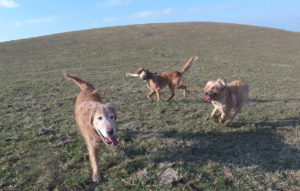Socialization is a frequently misunderstood concept in dog training. It’s more (time) critical with puppies, but even for adult dogs we need to continue to provide good (not bad, and not neutral) experiences with the world. For dogs who are genetically more stable/resilient, we don’t need to work as hard. For dogs who are more anxious, we may need to do more conscious and structured training to maintain progress.
Of my current dogs, Griffin (8 years) and Tonks (18 months) are fairly stable. Viktor (2 years) is more anxious but definitely has an easier time than most of the anxious dogs I work with and definitely is more resilient than my past dog Luna.
Here are a few of our activities for dog-dog socialization:

Golden party.
Training Class: In a class environment my dogs have a great time (not bad and not neutral!) around other dogs. My dogs are learning they can’t always play with other dogs and that they can focus with me even when other dogs are around. The structured activities provide a great way to spend time around other dogs of different sizes and types. My dogs spend more time assisting me in classes as demo dogs than truely as student teams ourselves, but it’s still great for them!
Walks: We try to find opportunities to walk with other people and dogs. We don’t do this as much as we should. Sometimes it happens as a plan and sometimes it happens spontaneously when we walk past/with dogs in public parks or at pet stores for a short period. Treats and fun with me make this a good experience (not bad – and not neutral!).
Play Time: This is an option I do less of than some may think – I want to be sure these are good experiences for my dogs. Tonks enjoys this more than my others, though Griffin has one very best friend German Shepherd Dog and I hope to create friends outside our family for Viktor. Play creates good experiences because it’s fun – but it also creates expectations of high arousal and excitement. This isn’t a bad thing – but if the only interaction a dog gets with other dogs is unstructured play (dog parks, some daycares), we often see dogs who get immediately and extremely excited the moment they see other dogs.

Golden party
This Weekend: We did a group playtime with Tonks and two friends on Saturday. They did a lot of chase (switching roles) and a little wrestling. Today Tonks and Griffin went on an off leash walk with a dog friend. There was some chase but much, much less than when we were in the confined indoor environment yesterday. Later on, Griffin went on an off leash walk
with a new ‘friend’ (used loosely – no play, just polite interactions).
Viktor’s Plans: Viktor hasn’t played with a dog outside of Griffin and Tonks since he was young. Part of this is we don’t know a lot of appropriate adult dogs and part is because I didn’t want to risk him being inappropriate with another dog. Poor play skill practice would be bad for him – those are habits I don’t want him to practice. But also, I didn’t want him to scare another dog. We’ve been doing muzzle training (to reduce my fear of him hurting someone else) and some structured training to prepare for introductions, hopefully in the near future. In the meantime, he does get a lot of dog socialization other than play/interaction through class time and walks.